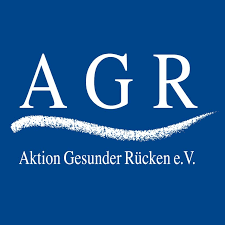Artificial intelligence (AI) has already found its way into many areas of our lives - including the world of work. For example, AI-based exoskeletons at manual workstations ensure ergonomic movements for workers and thus fewer back-related absences due to illness. In the office, too, AI can make a contribution to greater ergonomics at the workplace: for example, as integrated PC software that recognizes an unhealthy sitting posture on the part of the user. Self-learning systems have the potential to positively change the work environment in the future as well. Aktion Gesunder Rücken (AGR) e. V. knows more.
Whether eye tracking in the office or exoskeletons (a support worn on the body) at manual workstations: AI is already making the work of many people easier, more efficient and more ergonomic. Artificial intelligence (AI) refers to machines or computer systems that can imitate human cognitive abilities. They are self-learning, can solve problems and make decisions. This makes them a valuable support for humans - not least in the workplace.
Artificial intelligence for manual work: less back pain, more well-being
According to the German Statutory Accident Insurance, musculoskeletal disorders are responsible for around a quarter of all sick days in Germany. This health risk is particularly prevalent for employees who have to do heavy lifting at work. Artificial intelligence can help prevent these overloads.
For example, an exoskeleton with an integrated AI early warning system can offer employees at manual workplaces several advantages. It provides support of up to 30 kg per lift, making work safer and easier. In addition, the AI identifies health risks to workers in real time: incorrect postures, incorrect lifting techniques or unergonomic movements are detected immediately. From this, individual safety precautions are determined and work processes are optimized using machine learning. All this means a significant plus in occupational safety and health management.
Projections for the ergonomics of tomorrow
What does the future hold for ergonomics in manual assembly? This question is also driving the scientists at the AIXLab research laboratory in Aachen. In cooperation with partners from research and industry, they are testing the interaction of AI solutions and manual workstations. Systems create and improve machine learning algorithms and provide instructions for assembly. These instructions are then displayed augmented reality-style on
projected onto the work surface and the workpiece to be machined. This is intended to provide workers with the best possible support during assembly.
Back-friendly working environment in the office - here, too, AI knows the right levers to pull
But artificial intelligence can not only make manual workplaces more ergonomic: Everyday office life also benefits from AI-based applications. With so-called eye tracking, it is possible to reduce mouse use through simple gaze control. On the one hand, this leads to a significant increase in efficiency, but also to a sustainable optimization of ergonomics at PC workstations. The dreaded "mouse arm" (RSI) can be prevented in this way.
However, pay attention to ergonomic design aspects not only during use, but also already when choosing a mouse and keyboard. For example, the companies Contour Design, Logitech and R-Go Tools have taken this on board and develop products with the aim of creating health-promoting and individual solutions. Even at the product design stage, developers take into account anthropometry (the study of human body dimensions), ergonomic principles and current health and safety guidelines. Working at a computer screen can quickly lead to an overload of the small muscles and tendons in the wrists and hands. That's why keyboards and mice are designed to be operated with minimal muscle strain, regardless of body size, stature, or left- or right-handedness.
Artificial intelligence can do much more: in the form of integrated computer software, for example, it can detect unhealthy sitting postures among users and draw their attention to them. The AI can also determine how much time has already been spent in front of the screen and prompt users to take regular exercise breaks. In this context, R-Go Tools has developed a break coach that reminds you to frequently interrupt work with small breaks. As you work, the R-Go Break software controls an LED light in the keyboard and mouse that changes color like a traffic light, indicating how healthy you are. You have the ability to personalize these settings to suit your needs and customize break times and frequencies. Whether it's stretching, adjusting the height of your desk, or taking a short walk, even a little downtime can help relax your muscles and get your circulation going. Of course, some solutions from Contour Design, Logitech and R-Go Tools have been awarded the Aktion Gesunder Rücken seal of approval.
A working world with AI: A coexistence of man and machine
From production and logistics to services such as care, artificial intelligence is already being used in many industries and fields of work. The working world of tomorrow will also be shaped by AI. As long as learning systems provide relief, greater autonomy or flexibility, their use will have a positive impact on employees. The goal must always be to develop and use AI in a way that is geared to people and their needs.
About Aktion Gesunder Rücken (AGR) e.V.
Aktion Gesunder Rücken (AGR) e. V. has been working for over 25 years to raise awareness of the importance of back-friendly conditions. The AGR "Tested & Recommended" seal of approval is an important decision-making aid for consumers. Everyday objects that are classified as particularly back-friendly by independent medical committees can be awarded the renowned seal.
Source: Hand in hand for back-friendly work - German press index (05.01.2023)
